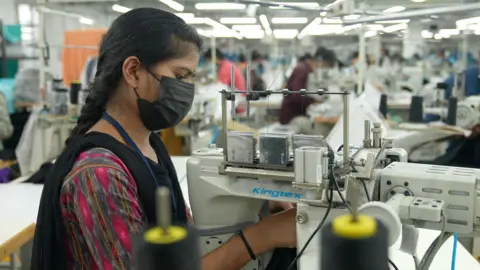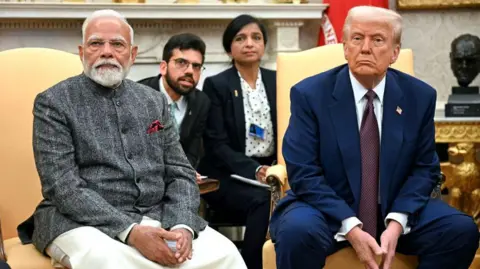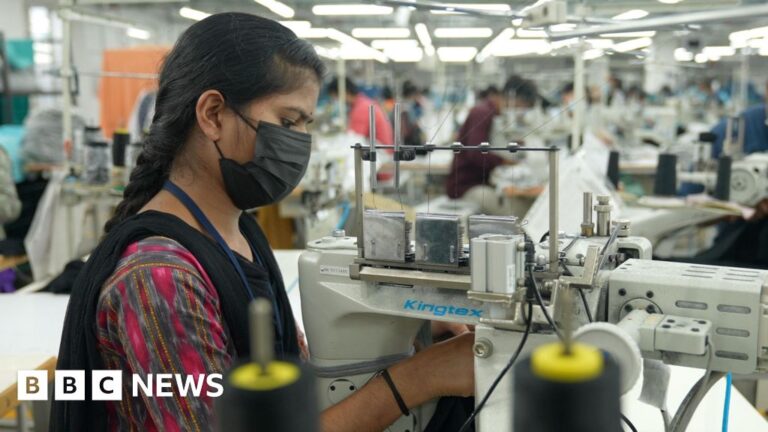BBC News
 Vishnu Vardhan, BBC News
Vishnu Vardhan, BBC NewsAn eerie silence hangs over N Krishnamurthy’s garment manufacturing unit in Tiruppur, one of India’s largest textile export hubs.
Only a fraction of some 200 industrial sewing machines on the floor are in operation, as workers make the last of the season’s children’s garment orders for some of the biggest US retailers.
At one end of the room, piles of fabric samples for new designs are gathering dust – casualties of US President Donald Trump’s steep 50% tariffs on India, set to kick in from Wednesday.
India is a major exporter of goods, including garments, shrimp and gems and jewellery, to the US. Trade experts say the high tariffs – including a 25% penalty for buying Russian oil and weapons – are akin to an embargo on Indian goods.
BBC correspondents visited key export hubs across India to assess how the trade uncertainties are impacting business owners and livelihoods.
Across Tiruppur – which contributes to a third of India’s $16bn (£11.93bn) exports of ready-to-wear garments to brands such as Target, Walmart, Gap and Zara – there’s acute anxiety about what the future holds.
“September onwards, there may be nothing left to do,” Krishnamurthy said, as clients have paused all orders.
He recently had to pause his expansion plans and bench nearly 250 new workers who were hired before the tariffs were imposed.
The timing of the announcement has made things worse because nearly half of annual sales for most export businesses are made during this period, in the run-up to Christmas.
Now these units are banking on the domestic market and on the upcoming Diwali season in India, to survive.
At another factory that makes underwear, we saw inventory of nearly $1m, meant for US stores, piled up with no takers.
“We were hoping India will ink a trade deal with the US. The entire production chain was frozen last month. How will I pay workers if this continues?” Siva Subramaniam, the owner of Raft Garments, told the BBC.
At a 50% tariff rate, an Indian-made shirt that once sold at $10 will cost US buyers $16.4 – far costlier than $14.2 from China, $13.2 from Bangladesh or $12 from Vietnam.
Even if duties ease to 25%, India will be less competitive than its Asian peers.
To soften the blow, the government has announced some measures – a suspension of import duties on raw materials, for instance. Trade talks with other countries have also gathered momentum to diversify markets. But many fear this is too little, too late.
“We can expect the diversion of trade, with US buyers moving to Mexico, Vietnam and Bangladesh,” said Ajay Srivastava of the Global Trade Research Initiative.

Some 1,200km (745 miles) away, at an export zone in Mumbai, hundreds of workers are busy polishing and packing diamonds, part of India’s $10bn gems and jewellery exports trade.
But jewellery brands here are nervous about the potential impact of the tariffs on their sales during September and October – when $3-4bn worth of jewellery gets shipped to the US.
While India’s new trade partnerships with the UK and Australia have opened up opportunities, years of effort to build a presence in the US could be undone in months, fears Adil Kotwal of Creation Jewellery, who sells 90% of his diamond-studded jewels in the US.
He works on thin margins of 3-4%, so even a 10% additional tariff rate is difficult to sustain. “Who can absorb these tariffs? Even US retailers will not be able to [do so],” Kotwal told the BBC.
Kotwal sources his stones from Surat city in neighbouring Gujarat state. In Surat, the world’s diamond-cutting and polishing hub, a crisis has been brewing long before the tariffs hit due to declining global demand and competition from lab-grown diamonds.
And now the tariffs are a double whammy.
American customers have vanished and factories that sustained nearly five million livelihoods are now operating for barely 15 days every month. Hundreds of contract workers have been sent on indefinite leave.
Inside a dimly lit diamond polishing unit on the city’s outskirts, rows of dusty, unused tables stretch out in silence. Nearby, broken CPUs lie scattered.
“This place used to be buzzing,” says a worker. “Many people were fired recently. We don’t know what will happen to us.”
Shailesh Mangukia, who built the unit, says he once employed 300 workers. Now only 70 remain. The number of diamonds polished every month has plunged from 2,000 to barely 300.
Local trade union leaders such as Bhavesh Tank say workers here face “decreasing wages, forced leave and shrinking monthly incomes”.

Many of India’s shrimp farmers, meanwhile, are considering switching to other products to survive the blow. India is one of the largest exporters of shrimp to the world – and the US is a major market.
Along with other duties, total tariffs on shrimps now stand to go up above 60% – a body blow for the sector as prices have dropped by $0.60-0.72 per kilo since the tariffs were first announced and are expected to fall further once the 50% rate comes into effect.
“This is the peak season for US buyers preparing for Christmas and New Year sales. Farmers here are just starting their new cultivation cycle. Trump’s tariffs caused great confusion. We’re unable to make any decisions,” Thota Jagadeesh, an exporter, told the BBC.
Hatchery operators say they’ve significantly reduced shrimp larvae production as a result.
“Previously, we produced an average of 100 million shrimp larvae annually. Now, we’re not even reaching 60-70 million,” said MS Varma of Srimannarayana Hatcheries in Veeravasaram town.
All of this could affect the livelihoods of half a million shrimp farmers directly and another 2.5 million indirectly, according to estimates.
In a country already reeling from a protracted crisis of job creation, these are worrying figures.
 Getty Images
Getty ImagesFor now, the impasse between India and the US continues. If anything, the environment for further trade negotiations has significantly deteriorated in the weeks gone by.
The latest round of trade talks which were set to begin in Delhi this week were reportedly called off, and US officials have doubled down on their criticism of India, accusing it of “cosying up” to Beijing and being a “laundromat” for Russia.
“The future of India-US talks now depends heavily on the Trump administration’s priorities, domestic as well as those involving Russia and China, among others,” Gopal Naddur of the Asia Group advisory firm told the BBC.
“For India’s policymakers and business leaders alike, the mantra will need to be: increase self-reliance, diversify, and leave no stone unturned.”
Follow BBC News India on Instagram, YouTube, X and Facebook.


